run flat TOYOTA C-HR 2020 Warranties & Maintenance Guides (in English)
[x] Cancel search | Manufacturer: TOYOTA, Model Year: 2020, Model line: C-HR, Model: TOYOTA C-HR 2020Pages: 260, PDF Size: 8.54 MB
Page 158 of 260
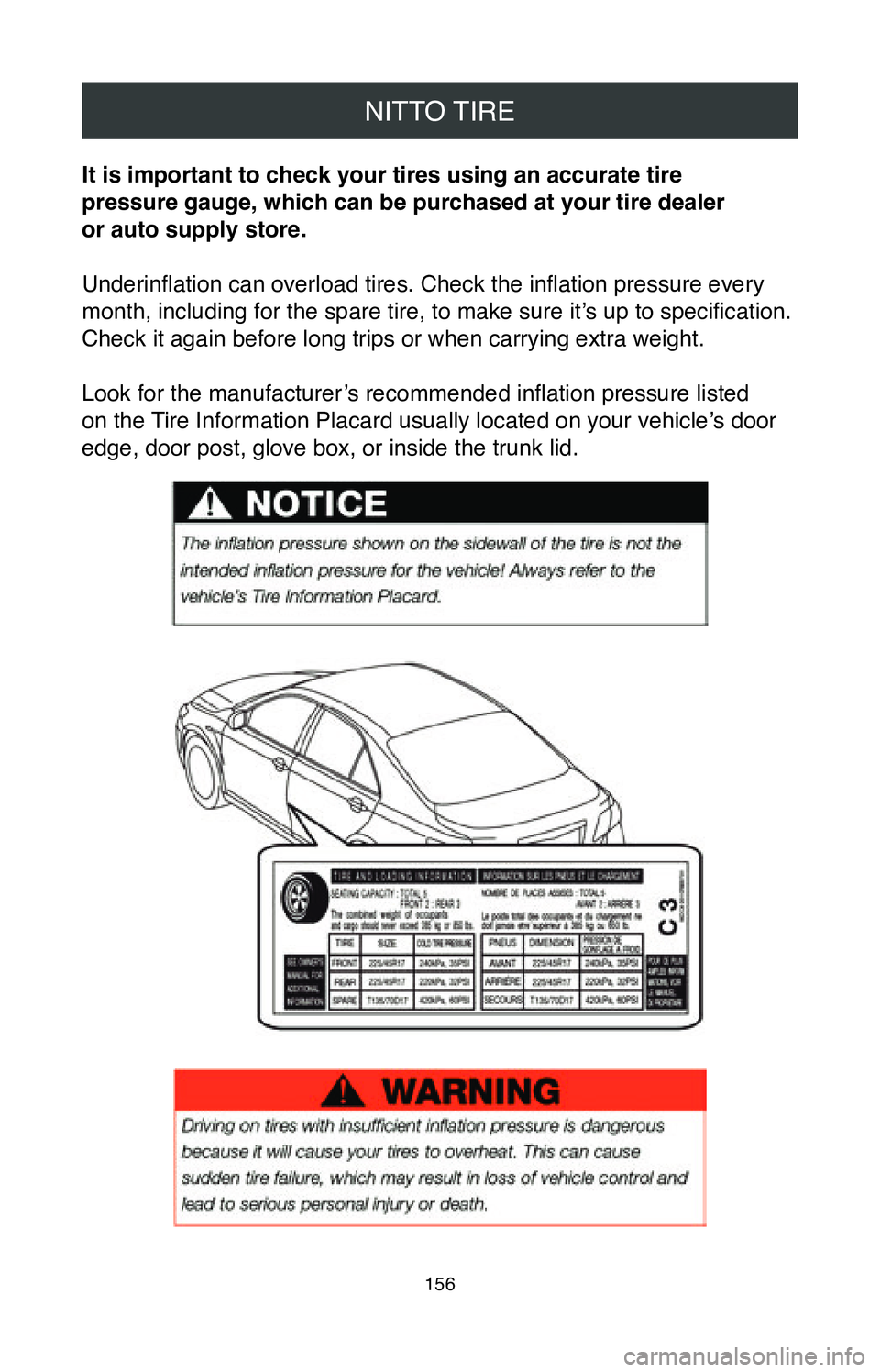
NITTO TIRE
156
It is important to check your tires using an accurate tire
pressure gauge, which can be purchased at your tire dealer
or auto supply store.
Underinflation can overload tires. Check the inflation pressure every
month, including for the spare tire, to make sure it’s up to specification.
Check it again before long trips or when carrying extra weight.
Look for the manufacturer’s recommended inflation pressure listed
on the Tire Information Placard usually located on your vehicle’s door
edge, door post, glove box, or inside the trunk lid.
Page 159 of 260
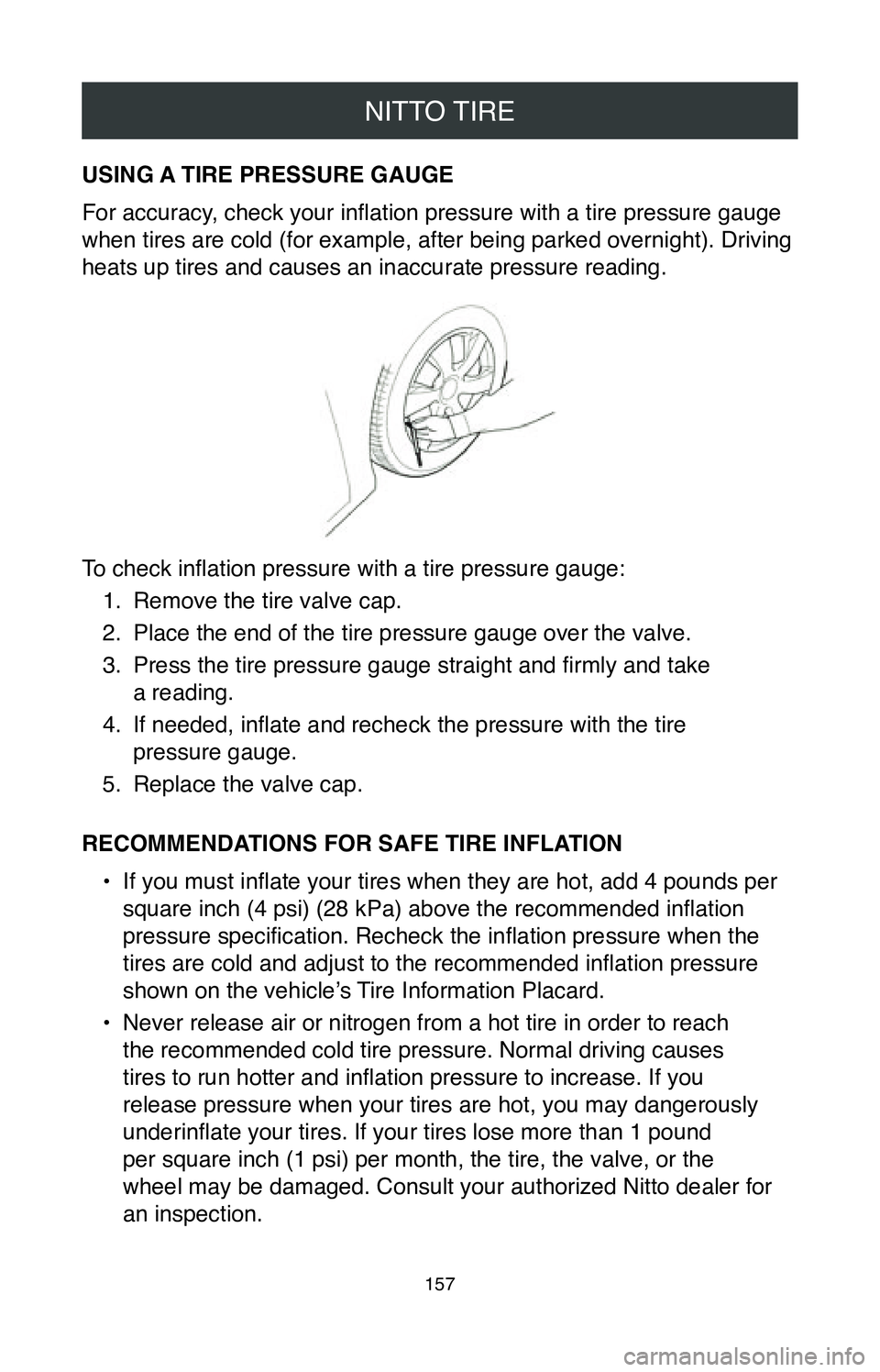
NITTO TIRE
157
USING A TIRE PRESSURE GAUGE
For accuracy, check your inflation pressure with a tire pressure gauge
when tires are cold (for example, after being parked overnight). Driving
heats up tires and causes an inaccurate pressure reading.
To check inflation pressure with a tire pressure gauge:1.
Remove the tire valve cap.
2.
Place the end of the tire pressure gauge over the valve.
3.
Press the tire pressure gauge straight and firmly and take
a reading.
4.
If needed, inflate and recheck the pressure with the tire
pressure gauge.
5.
Replace the valve cap.
RECOMMENDATIONS FOR SAFE TIRE INFLATION •
If you must inflate your tires when they are hot, add 4 pounds per
square inch (4 psi) (28 kPa) above the recommended inflation
pressure specification. Recheck the inflation pressure when the
tires are cold and adjust to the recommended inflation pressure
shown on the vehicle’s Tire Information Placard.
•
Never release air or nitrogen from a hot tire in order to reach
the recommended cold tire pressure. Normal driving causes
tires to run hotter and inflation pressure to increase. If you
release pressure when your tires are hot, you may dangerously
underinflate your tires. If your tires lose more than 1 pound
per square inch (1 psi) per month, the tire, the valve, or the
wheel may be damaged. Consult your authorized Nitto dealer for
an inspection.
Page 193 of 260
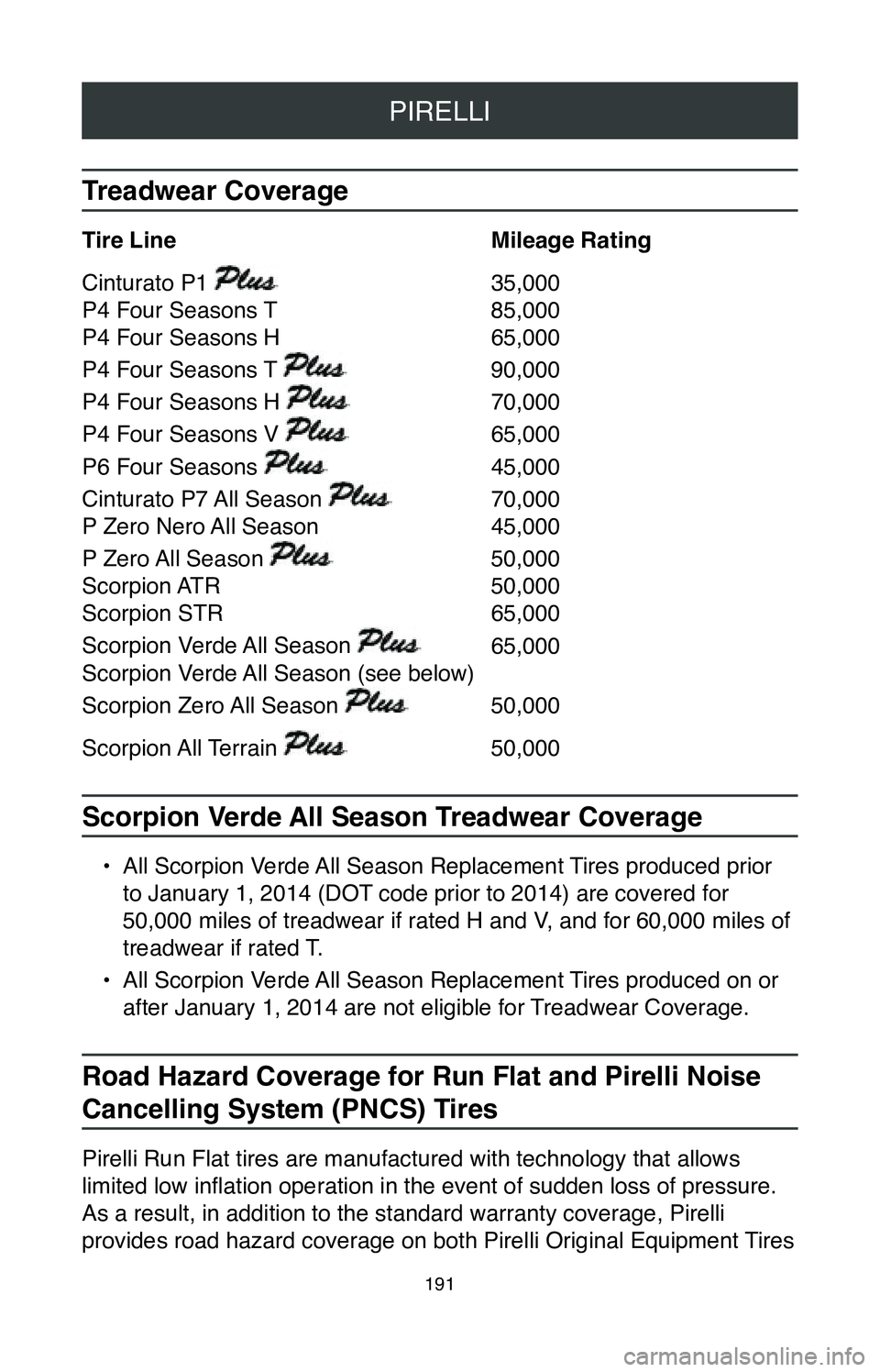
PIRELLI
191
Treadwear Coverage
Tire Line Mileage Rating
Cinturato P1
35,000
P4 Four Seasons T
85,000
P4 Four Seasons H
65,000
P4 Four Seasons T
90,000
P4 Four Seasons H
70,000
P4 Four Seasons V
65,000
P6 Four Seasons
45,000
Cinturato P7 All Season
70,000
P Zero Nero All Season
45,000
P Zero All Season
50,000
Scorpion ATR
50,000
Scorpion STR
65,000
Scorpion Verde All Season
65,000
Scorpion Verde All Season (see below)
Scorpion Zero All Season 50,000
Scorpion All Terrain
50,000
Scorpion Verde All Season Treadwear Coverage
• All Scorpion Verde All Season Replacement Tires produced prior
to January 1, 2014 (DOT code prior to 2014) are covered for
50,000 miles of treadwear if rated H and V, and for 60,000 miles of
treadwear if rated T.
•
All Scorpion Verde All Season Replacement Tires produced on or
after January 1, 2014 are not eligible for Treadwear Coverage.
Road Hazard Coverage for Run Flat and Pirelli Noise
Cancelling System (PNCS) Tires
Pirelli Run Flat tires are manufactured with technology that allows
limited low inflation operation in the event of sudden loss of pressure.
As a result, in addition to the standard warranty coverage, Pirelli
provides road hazard coverage on both Pirelli Original Equipment Tires
Page 194 of 260
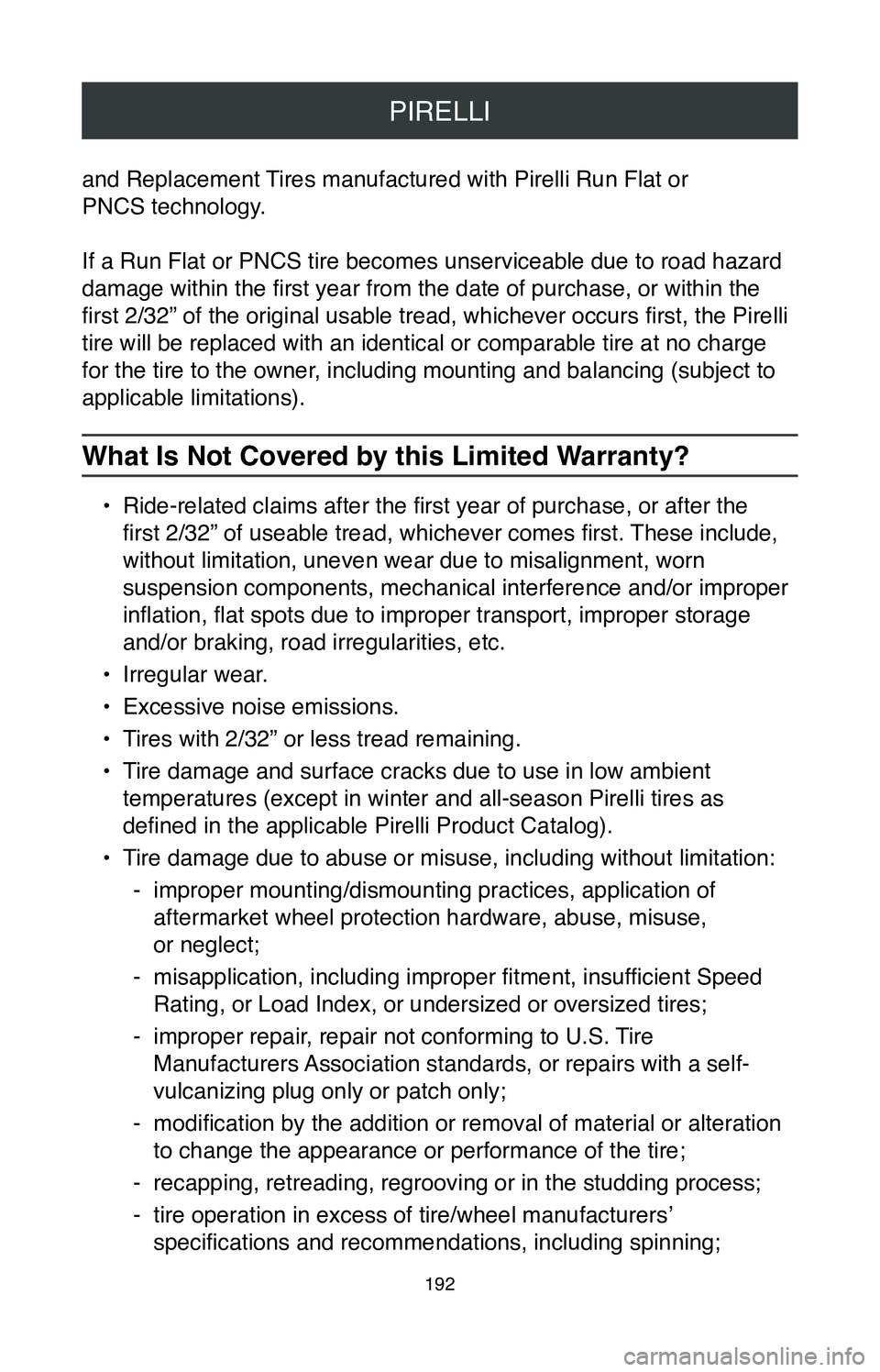
PIRELLI
192
and Replacement Tires manufactured with Pirelli Run Flat or
PNCS technology.
If a Run Flat or PNCS tire becomes unserviceable due to road hazard
damage within the first year from the date of purchase, or within the
first 2/32” of the original usable tread, whichever occurs first, the Pirelli
tire will be replaced with an identical or comparable tire at no charge \
for the tire to the owner, including mounting and balancing (subject to
applicable limitations).
What Is Not Covered by this Limited Warranty?
• Ride-related claims after the first year of purchase, or after the
first 2/32” of useable tread, whichever comes first. These include,
without limitation, uneven wear due to misalignment, worn
suspension components, mechanical interference and/or improper
inflation, flat spots due to improper transport, improper storage
and/or braking, road irregularities, etc.
•
Irregular wear.
•
Excessive noise emissions.
•
Tires with 2/32” or less tread remaining.
•
Tire damage and surface cracks due to use in low ambient
temperatures (except in winter and all-season Pirelli tires as
defined in the applicable Pirelli Product Catalog).
•
Tire damage due to abuse or misuse, including without limitation:
- improper mounting/dismounting practices, application of
aftermarket wheel protection hardware, abuse, misuse,
or neglect;
- misapplication, including improper fitment, insufficient Speed
Rating, or Load Index, or undersized or oversized tires;
-improper repair, repair not conforming to U.S. Tire
Manufacturers Association standards, or repairs with a self-
vulcanizing plug only or patch only;
- modification by the addition or removal of material or alteration
to change the appearance or performance of the tire;
-recapping, retreading, regrooving or in the studding process;
- tire operation in excess of tire/wheel manufacturers’
specifications and recommendations, including spinning;
Page 195 of 260
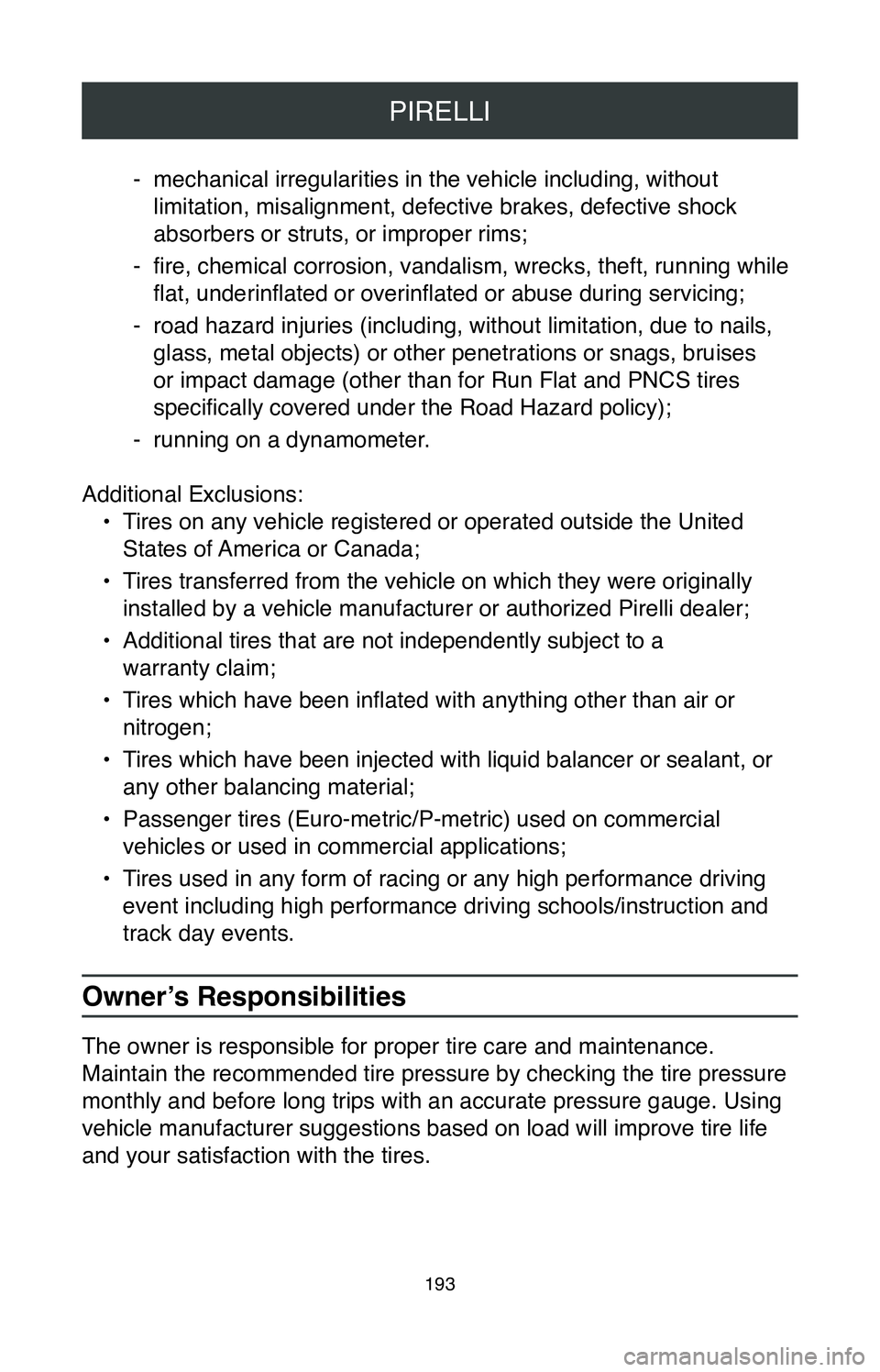
PIRELLI
193
-mechanical irregularities in the vehicle including, without
limitation, misalignment, defective brakes, defective shock
absorbers or struts, or improper rims;
- fire, chemical corrosion, vandalism, wrecks, theft, running while
flat, underinflated or overinflated or abuse during servicing;
- road hazard injuries (including, without limitation, due to nails, glass, metal objects) or other penetrations or snags, bruises
or impact damage (other than for Run Flat and PNCS tires
specifically covered under the Road Hazard policy);
-running on a dynamometer.
Additional Exclusions: •
Tires on any vehicle registered or operated outside the United
States of America or Canada;
•
Tires transferred from the vehicle on which they were originally
installed by a vehicle manufacturer or authorized Pirelli dealer;
•
Additional tires that are not independently subject to a
warranty claim;
•
Tires which have been inflated with anything other than air or
nitrogen;
•
Tires which have been injected with liquid balancer or sealant, or
any other balancing material;
•
Passenger tires (Euro-metric/P-metric) used on commercial
vehicles or used in commercial applications;
•
Tires used in any form of racing or any high performance driving
event including high performance driving schools/instruction and
track day events.
Owner’s Responsibilities
The owner is responsible for proper tire care and maintenance.
Maintain the recommended tire pressure by checking the tire pressure
monthly and before long trips with an accurate pressure gauge. Using
vehicle manufacturer suggestions based on load will improve tire life
and your satisfaction with the tires.
Page 202 of 260
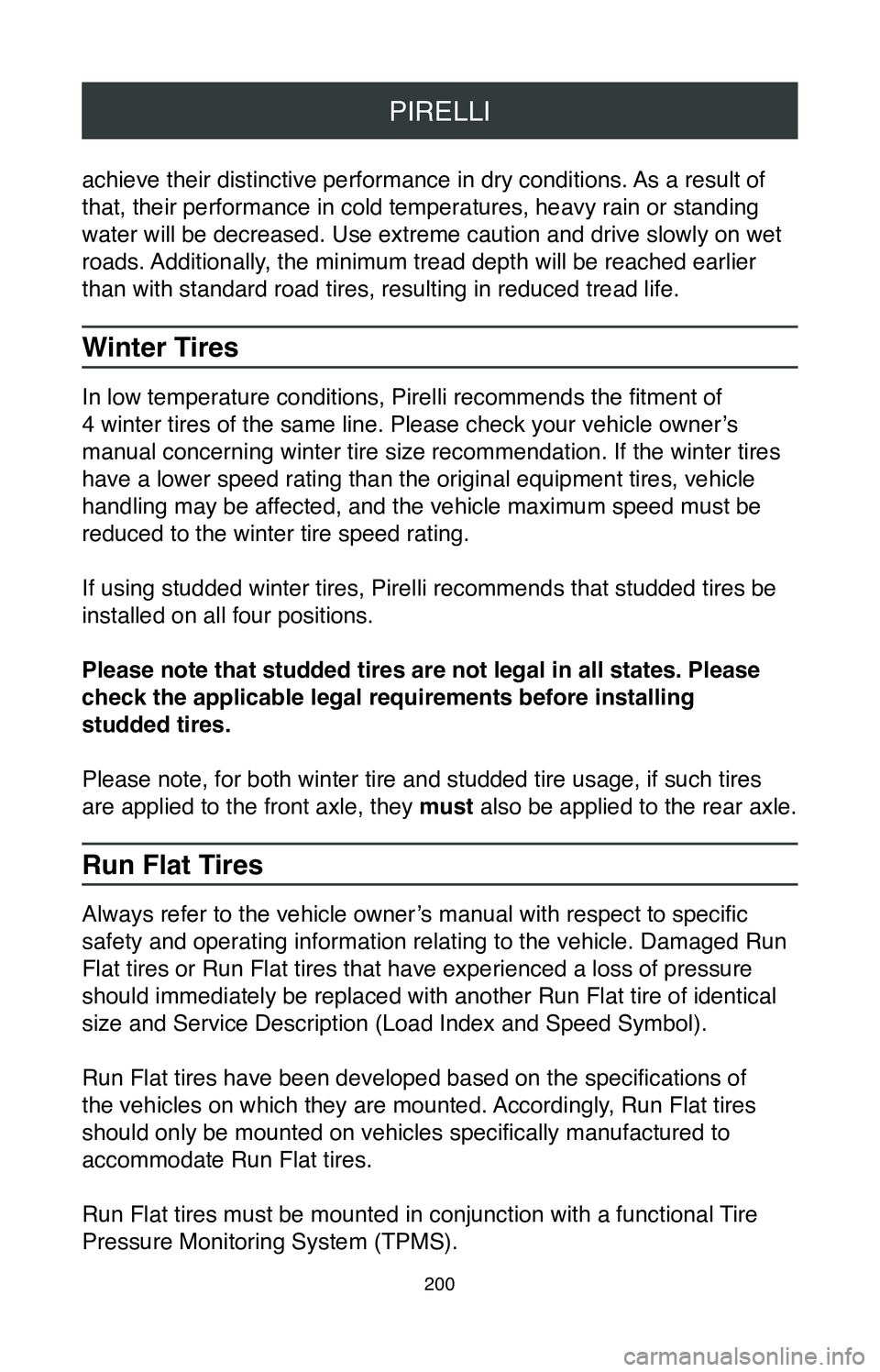
PIRELLI
200
achieve their distinctive performance in dry conditions. As a result of
that, their performance in cold temperatures, heavy rain or standing
water will be decreased. Use extreme caution and drive slowly on wet
roads. Additionally, the minimum tread depth will be reached earlier
than with standard road tires, resulting in reduced tread life.
Winter Tires
In low temperature conditions, Pirelli recommends the fitment of
4 winter tires of the same line. Please check your vehicle owner’s
manual concerning winter tire size recommendation. If the winter tires
have a lower speed rating than the original equipment tires, vehicle
handling may be affected, and the vehicle maximum speed must be
reduced to the winter tire speed rating.
If using studded winter tires, Pirelli recommends that studded tires be \
installed on all four positions.
Please note that studded tires are not legal in all states. Please
check the applicable legal requirements before installing
studded tires.
Please note, for both winter tire and studded tire usage, if such tires \
are applied to the front axle, they must also be applied to the rear axle.
Run Flat Tires
Always refer to the vehicle owner’s manual with respect to specific
safety and operating information relating to the vehicle. Damaged Run
Flat tires or Run Flat tires that have experienced a loss of pressure
should immediately be replaced with another Run Flat tire of identical
size and Service Description (Load Index and Speed Symbol).
Run Flat tires have been developed based on the specifications of
the vehicles on which they are mounted. Accordingly, Run Flat tires
should only be mounted on vehicles specifically manufactured to
accommodate Run Flat tires.
Run Flat tires must be mounted in conjunction with a functional Tire
Pressure Monitoring System (TPMS).
Page 210 of 260
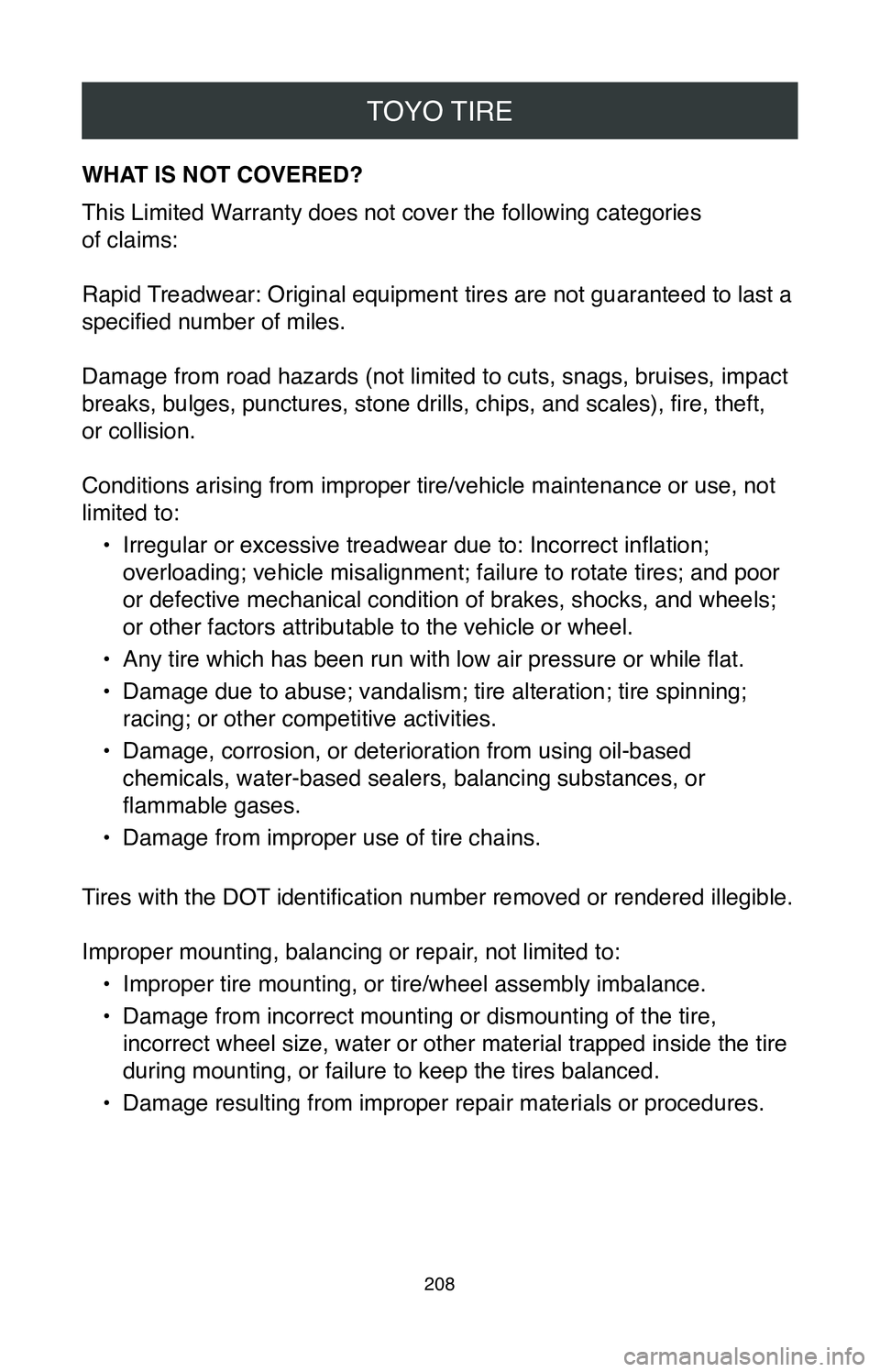
TOYO TIRE
208
WHAT IS NOT COVERED?
This Limited Warranty does not cover the following categories
of claims:
Rapid Treadwear: Original equipment tires are not guaranteed to last a
specified number of miles.
Damage from road hazards (not limited to cuts, snags, bruises, impact
breaks, bulges, punctures, stone drills, chips, and scales), fire, theft,
or collision.
Conditions arising from improper tire/vehicle maintenance or use, not
limited to:
•
Irregular or excessive treadwear due to: Incorrect inflation;
overloading; vehicle misalignment; failure to rotate tires; and poor
or defective mechanical condition of brakes, shocks, and wheels;
or other factors attributable to the vehicle or wheel.
•
Any tire which has been run with low air pressure or while flat.
•
Damage due to abuse; vandalism; tire alteration; tire spinning;
racing; or other competitive activities.
•
Damage, corrosion, or deterioration from using oil-based
chemicals, water-based sealers, balancing substances, or
flammable gases.
•
Damage from improper use of tire chains.
Tires with the DOT identification number removed or rendered illegible.
Improper mounting, balancing or repair, not limited to: •
Improper tire mounting, or tire/wheel assembly imbalance.
•
Damage from incorrect mounting or dismounting of the tire,
incorrect wheel size, water or other material trapped inside the tire
during mounting, or failure to keep the tires balanced.
•
Damage resulting from improper repair materials or procedures.
Page 215 of 260
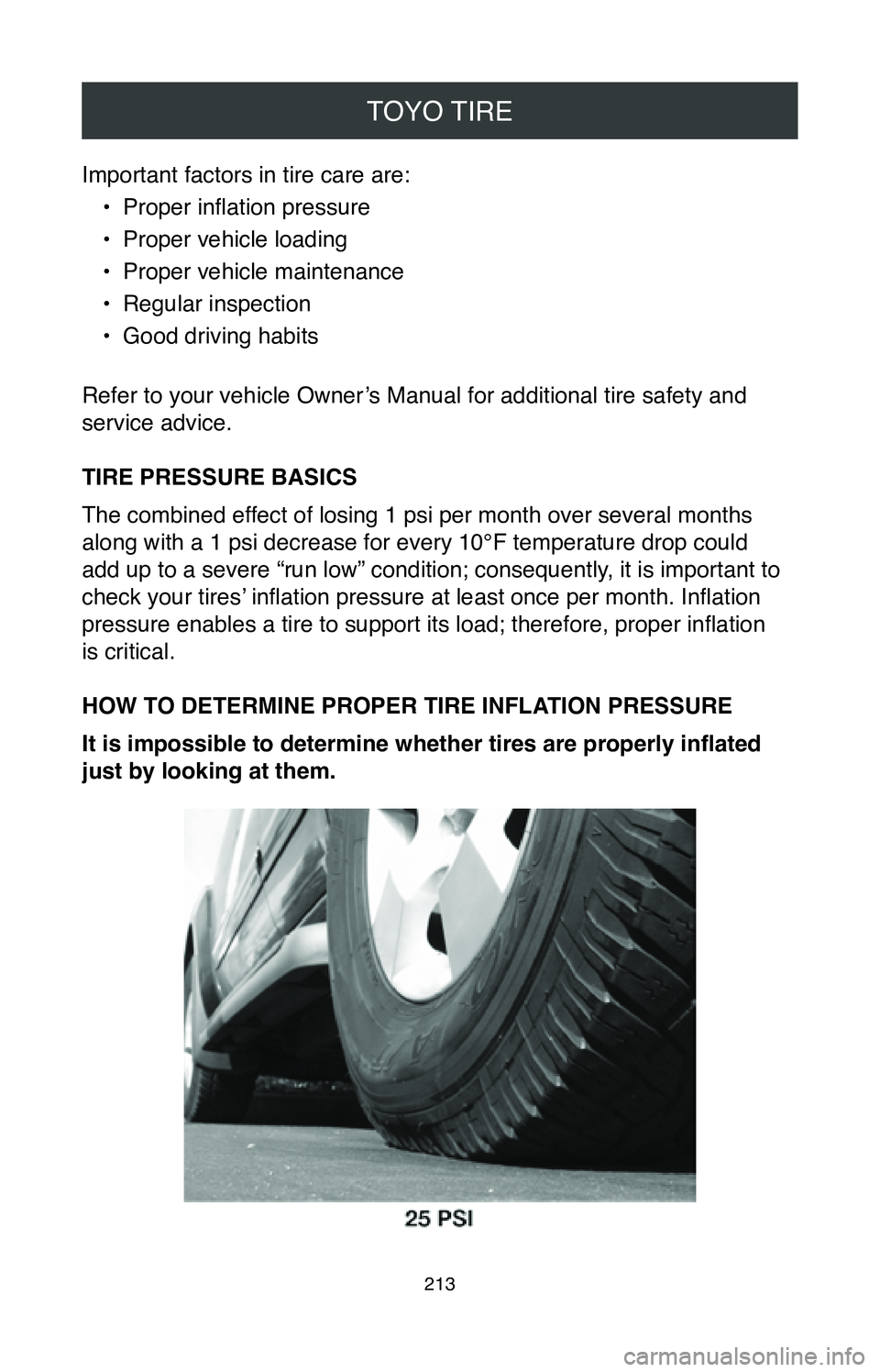
TOYO TIRE
213
Important factors in tire care are:•
Proper inflation pressure
•
Proper vehicle loading
•
Proper vehicle maintenance
•
Regular inspection
•
Good driving habits
Refer to your vehicle Owner’s Manual for additional tire safety and
service advice.
TIRE PRESSURE BASICS
The combined effect of losing 1 psi per month over several months
along with a 1 psi decrease for every 10°F temperature drop could
add up to a severe “run low” condition; consequently, it is important to
check your tires’ inflation pressure at least once per month. Inflation
pressure enables a tire to support its load; therefore, proper inflation
is critical.
HOW TO DETERMINE PROPER TIRE INFLATION PRESSURE
It is impossible to determine whether tires are properly inflated
just by looking at them.
Page 217 of 260
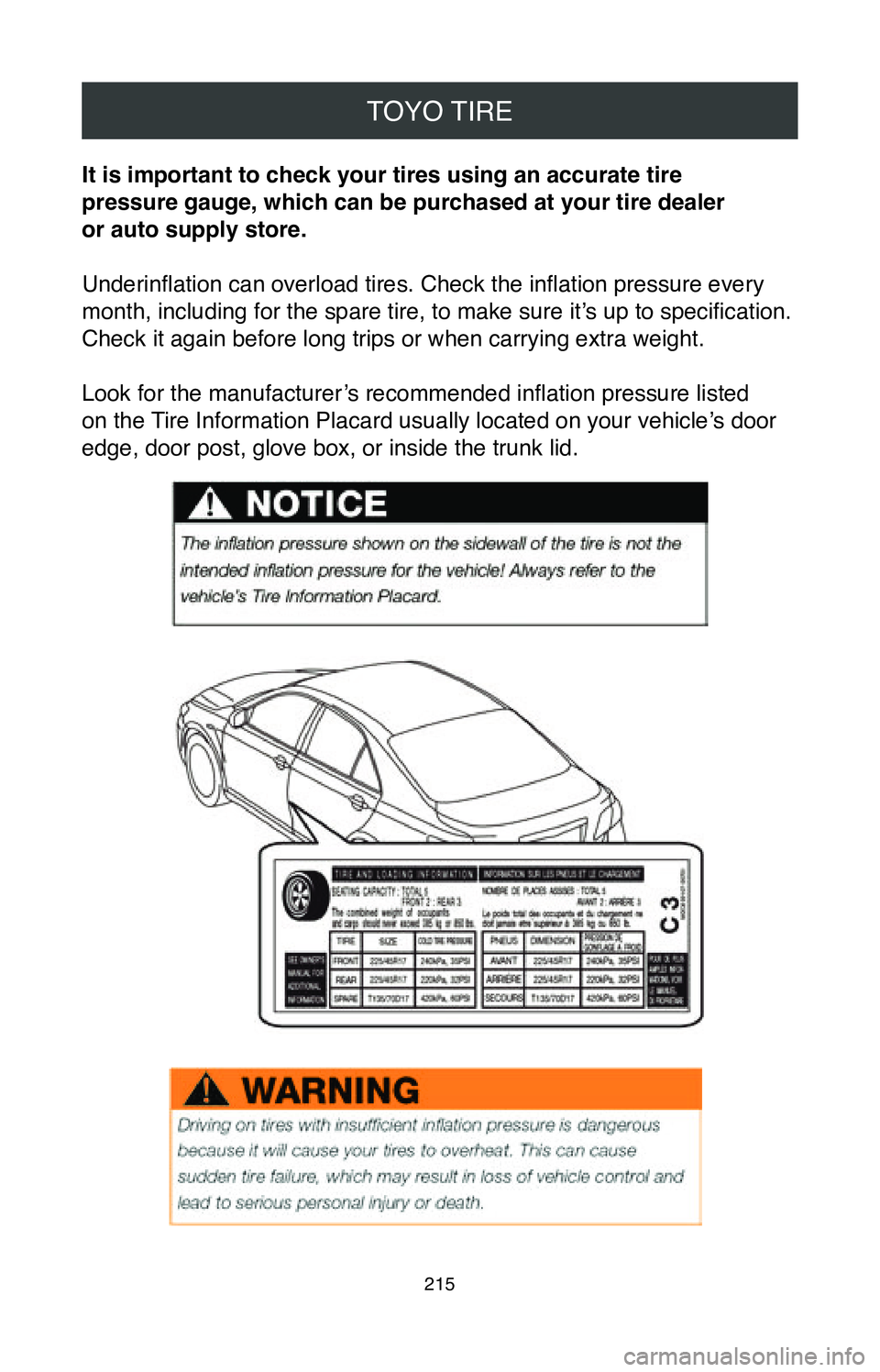
TOYO TIRE
215
It is important to check your tires using an accurate tire
pressure gauge, which can be purchased at your tire dealer
or auto supply store.
Underinflation can overload tires. Check the inflation pressure every
month, including for the spare tire, to make sure it’s up to specification.
Check it again before long trips or when carrying extra weight.
Look for the manufacturer’s recommended inflation pressure listed
on the Tire Information Placard usually located on your vehicle’s door
edge, door post, glove box, or inside the trunk lid.
Page 218 of 260
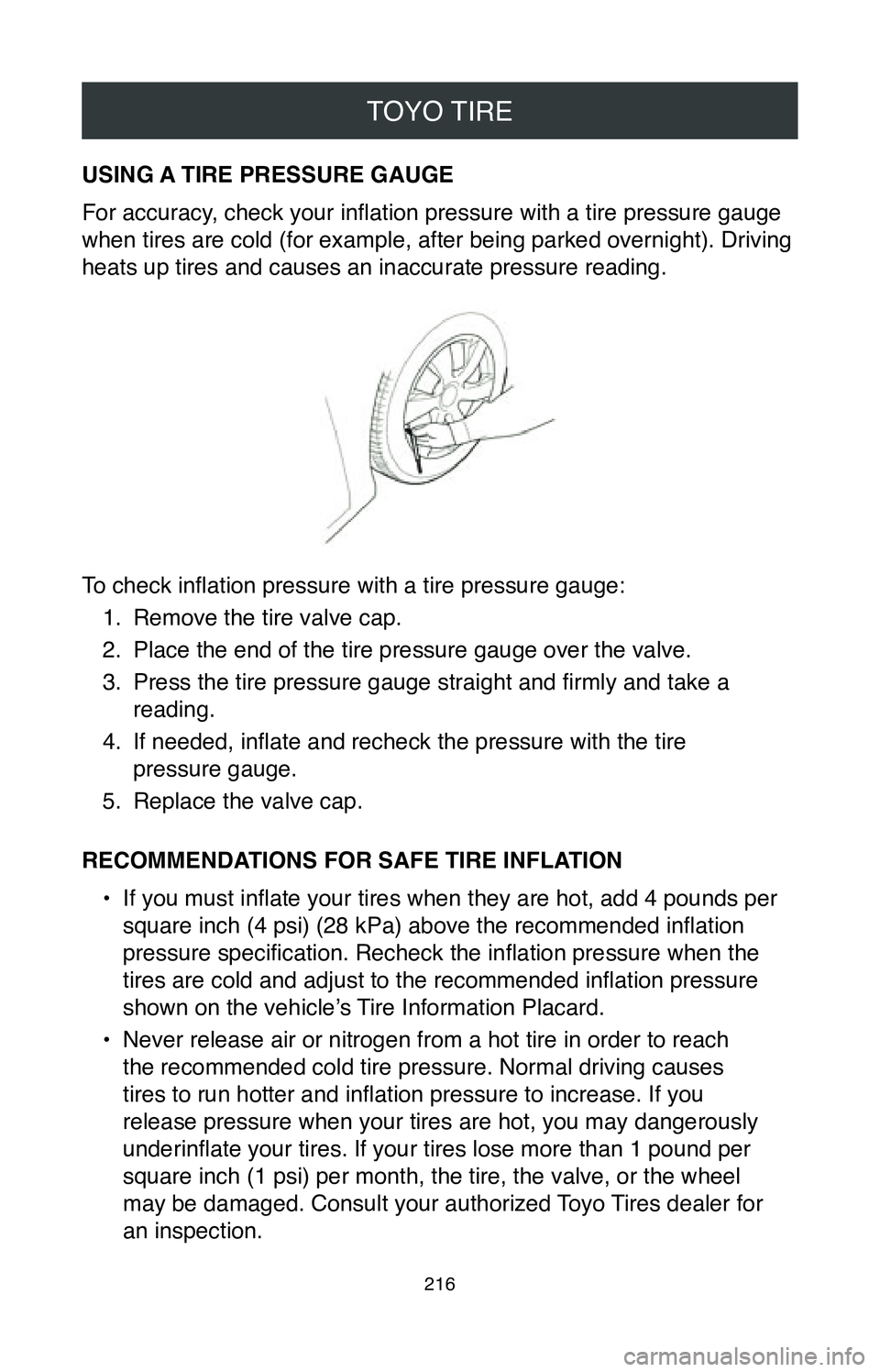
TOYO TIRE
216
USING A TIRE PRESSURE GAUGE
For accuracy, check your inflation pressure with a tire pressure gauge
when tires are cold (for example, after being parked overnight). Driving
heats up tires and causes an inaccurate pressure reading.
To check inflation pressure with a tire pressure gauge:1.
Remove the tire valve cap.
2.
Place the end of the tire pressure gauge over the valve.
3.
Press the tire pressure gauge straight and firmly and take a
reading.
4.
If needed, inflate and recheck the pressure with the tire
pressure gauge.
5.
Replace the valve cap.
RECOMMENDATIONS FOR SAFE TIRE INFLATION •
If you must inflate your tires when they are hot, add 4 pounds per
square inch (4 psi) (28 kPa) above the recommended inflation
pressure specification. Recheck the inflation pressure when the
tires are cold and adjust to the recommended inflation pressure
shown on the vehicle’s Tire Information Placard.
•
Never release air or nitrogen from a hot tire in order to reach
the recommended cold tire pressure. Normal driving causes
tires to run hotter and inflation pressure to increase. If you
release pressure when your tires are hot, you may dangerously
underinflate your tires. If your tires lose more than 1 pound per
square inch (1 psi) per month, the tire, the valve, or the wheel
may be damaged. Consult your authorized Toyo Tires dealer for
an inspection.